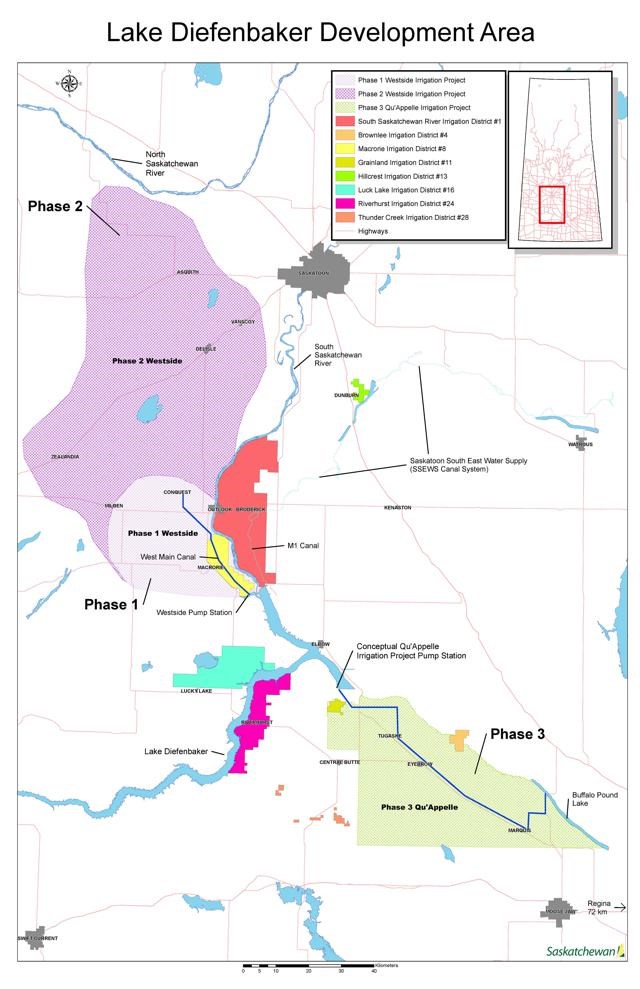Regina– Carrots, beets, lettuce, corn, cabbage, cucumbers and, yes, potatoes – all of these could soon be produced in large scale within Saskatchewan over the next decade. It’s the promise of high-value crops, and the value-added processing that goes with it, that the Government of Saskatchewan is aiming for in its announcement on July 2 of a $4 billion, 10-year expansion of the province’s irrigation network centred on Lake Diefenbaker.
If fully built out, the actual capital costs would be much higher than that, as that cost does not include the “last mile,” the actual irrigation equipment farmers need to put in their fields like pivots, pumps and electrical hookups required to get the water from the irrigation canals onto the actual crops. Nor would it include the capital equipment cost for farmers growing new, specialty crops.
Premier Scott Moe and Legislative Secretary Lyle Stewart (a former agriculture minister) made the announcement in Regina on the second last day of the spring legislative session. With a fall election scheduled on Oct. 26, this big announcement will likely form a major plank in the Saskatchewan Party’s re-election platform.
Moe called it the “first steps in a generational project that will impact our Saskatchewan agricultural sector and the entire province for the next century. This project will fulfill the vision of Prime Minister John Diefenbaker to ensure the prosperity of Saskatchewan people.”
He went on, “Agriculture continues to be the backbone of our economy and in no time is that more evident than this year. As we address the COVID-19, our producers have made tremendous progress in diversifying the crop production that they are producing and attracting more value-added processing into the crop increase irrigation opportunities to force his work. And in turn, increase on farm profitability, increase our value added processing opportunities as well as attract business there is a direct benefit to our local economies.”
After the Gardiner Dam was completed in 1967, the initial phase of irrigation projects were completed by 1972, but not much has happened since then.
The new proposed project would more than double the amount of irrigated land in Saskatchewan, adding up to 500,000 acres under irrigation. The July 2 announcement allocated $22.5 million for preliminary engineering and initial construction.
The first phase of the project is estimated to come it at $500 million and would rehabilitate and expand the Westside irrigation canal system. The idea would be to get this nearly complete system up-and-running in short order, bringing 80,000 acres in the area under irrigation. Stewart called it “shovel-ready.”
Phases 2 and 3 are expected to cost up to $3.5 billion, not counting the costs to the individual farmers connecting to the system and setting up their own irrigation equipment. It is expected to create 2,500 jobs for the duration of the project.
Phase 2 will see the further expansion and buildout of the Westside Irrigation Project, adding an additional 260,000 acres of irrigable land. Once fully built and developed, the project will eventually see land made available for irrigation near Macrorie, Milden, Zealandia, and as far north as Delisle and Asquith.
Phase 3 will see the buildout of the Qu’Appelle �鶹��ýAV Irrigation Project, adding an estimated 120,000 acres of irrigable land. Starting at Lake Diefenbaker and going south, the project would run near the communities of Tugaske, Eyebrow, down to Marquis and into Buffalo Pound Lake.
“It would provide the Moose Jaw-Regina corridor and southern Saskatchewan with a secure source of water for the next century and act as a catalyst for significant industrial expansion in the years to come,” Moe noted.
Moe said that in recent years, a major food processor had looked at setting up in Saskatchewan, but chose not to do so as there was insufficient irrigated land available to contract.
While there was no announcement of federal funding, Moe said, “The federal government is keenly interested in participating this project. I believe they ran on it, to some degree, in the last federal election.”
Stewart said, “Yes, the farmer pays for the connection and getting the irrigation equipment, the pivots, the electrical hookups, things of that nature.”
He didn’t know what the costs would be for the farmers to hook up, but, “It will be substantial for individual producers.”
He noted the Ministry of Agriculture has a program that helps with that as well as “irrigation experts that can advise producers on virtually all aspects of irrigated production for those who are not experienced in it.
He felt producers would take advantage of the opportunity, and “I know that lending institutions are very keen to lend money for irrigation expansion, because they recognize that it is substantial increase in production and profitability follows along with that.”




